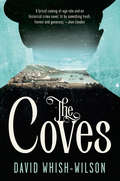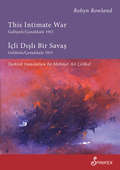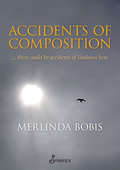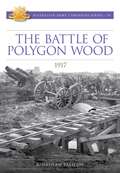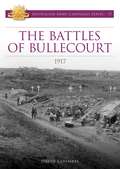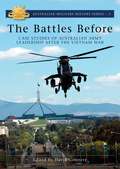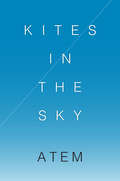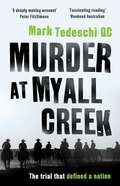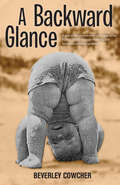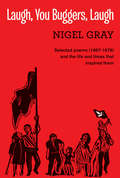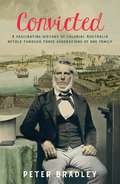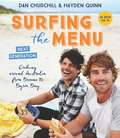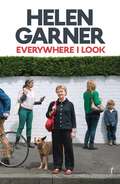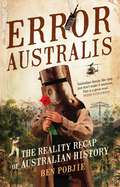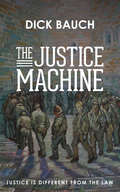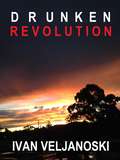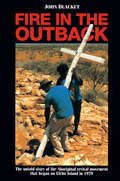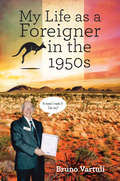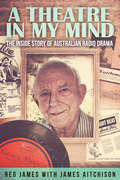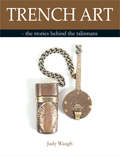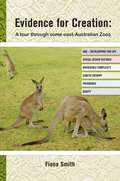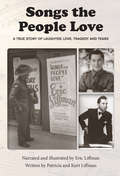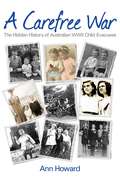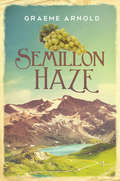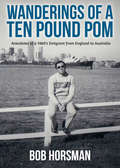- Table View
- List View
The Coves
by David Whish-WilsonSan Francisco, 1849: a place gripped by gold fever, swarming with desperate men come to seek their fortune. Among them are former convicts, Australians quick to seize control in a town without masters, a town for the taking. Into this world steps an Australian boy in search of his mother. Just twelve years old, and all alone in a time of opportunism, loyalty and violent betrayal, Samuel Bellamy must learn to become one of the Sydney Coves if he is to survive.
This Intimate War Gallipoli/Canakkale 1915: Icli Disli Bir Savas: Gelibolu/Canakkale 1915
by Mehmet Ali Celikel Robyn Rowland"Very few collections bring home so powerfully the vulnerability of individuals in the face of history," writes Lisa Gorton of Robyn Rowland's powerful poems recording the experiences of soldiers, nurses and doctors, women munitions workers, wives, mothers, composers, painters and poets during the Gallipolli War,1915. It began with the Battle of Çanakkale and the defeat of the British navy. The land battle was hand-to-hand killing, the physical closeness of its soldiers unmasking the depersonalization of the propaganda of war. Importantly, the book finishes with a poem on women's friendship 100 years after the war, and the healing nature of love.
Accidents of Composition
by Merlinda BobisIs it the sun a hole sucking in a bird or Icarus about to singe the sun? Which composes which? The poet asks as she circumnavigates the globe, history, and an inner universe. When it responds, there's the small shudder, the sprawl of a spin, or the quiet before and after a full circle. The eyes catch a black bird close to an eerie sun. Instantly, a poem: an accident of composition. Or a tree, rock, light from a story heard, dreamt, read or remembered returns as if it were the only tree, rock, light in the planet. The poet is caught, returned to her first heart: poetry. After four novels, Merlinda offers poems from the stillness of contemplation to the spinning of tales, then to passage across different histories. Glass becomes eternal greens underwater, fish gossip about colonisation, a gumnut turns dissident, and the dreams of Captain Cook and Pigafetta circumnavigate the globe leaving a trail of blood, beads, and the scent of cloves. But in between, the poet hopes: ‘there could be accidents / of kindness here.'
The Battle of Polygon Wood 1917 (Australian Army Campaigns #19)
by Jonathan PasslowBuoyed by the success of the 1st and 2nd Australian divisions in the Battle of Menin Road, the men of the 4th and 5th Australian divisions filed into the front line ready for the next phase of the battle. Ahead of them lay the blackened remnants of Polygon Wood, a desolate expanse of splintered stumps shattered by the devastating shellfire. The view across no man’s land revealed lines of German barbed wire and a criss-cross of heavily defended trenches. Here and there the Australians could also see solid concrete pillboxes dotted around the landscape. In the centre of the battlefield sat a huge man-made mound of earth — the Butte. Once the stop-butte for an old artillery range, this dominating feature was fortified with machine-guns, laced with barbed wire and riddled with tunnels and dugouts. The Battle of Polygon Wood was the second phase in the British forces’ advance on Passchendaele. Success at Polygon Wood would place Broodseinde Ridge within the Second Army’s reach. But the entire operation was almost blindsided by a German counter-attack on the eve of the battle. The critical situation on the Anzac Corps right was only saved by Pompey Elliott’s 15th Brigade whose desperate efforts to contain the German attack and seize the Second Army’s objectives turned a ‘fine success’ into a ‘splendid victory’. But, as author Jonathan Passlow describes in Polygon Wood 1917, this was a victory that was by no means assured and in which luck would play its part.
The Battles of Bullecourt: 1917 (Australian Army Campaigns #17)
by Dr David CoombesIn April-May 1917 the sleepy hamlet of Bullecourt in northern France became the focus of two battles involving Australian and British troops. Given the unique place in this nation’s military history that both battles occupy, surprisingly little has been written on the AIF’s achievements at Bullecourt. The First Battle of Bullecourt marked the Australians’ introduction to the latest battlefield weapon — the tank. This much-lauded weapon failed dismally amid enormous casualties. Despite this, two infantry brigades from the 4th Australian Division captured parts of the formidable Hindenburg Line with minimal artillery and tank support, repulsing German counter-attacks until forced to withdraw. In the second battle, launched with a preliminary artillery barrage, more Australian divisions were forced into the Bullecourt ‘meat-grinder’ and casualties soared to over 7000. Again Australian soldiers fought hard to capture parts of the enemy line and hold them against savage counter-attacks. Bullecourt became a charnel-house for the AIF. Many who had endured the nightmare of Pozières considered Bullecourt far worse. And for what? While Field Marshal Sir Douglas Haig considered its capture ‘among the great achievements of the war’, the village that cost so many lives held no strategic value whatsoever.
The Battles Before: Case Studies of Australian Army Leadership After the Vietnam War (Australian Military History #3)
by David ConneryMuch of Australia’s military history literature focuses on battles and the way generals plan and prosecute an action or campaign. But what do generals do when they are not fighting battles? The Battles Before examines the role of senior leaders in preparing an army for war — fighting bureaucratic battles, mobilising forces for operations, or preparing for a future that is impossible to anticipate. The five cases examined in this book focus on strategic leadership and describe how major organisations grapple with political, strategic, economic and cultural change over time. The first three case studies analyse a series of pivotal moments in the history of the Australian Army: the dramatic downsizing that followed the Vietnam War, the seminal 1985 Dibb Review, and the build-up to the East Timor intervention in 1999. Further cases describe planning within a large organisation, particularly the way senior leaders grapple with the demands of multiple operations while facing significant impetus for force modernisation. The final chapter focuses on the crucial role of the Army&’s leadership in developing the next generation of leaders. The book concludes with a series of insights into the study of command in peacetime and its relevance to wartime command, particularly given the challenges that face peacetime commanders who operate within considerable constraints. The Battles Before uses recently declassified documents and interviews with key participants in a meticulous examination of a 30-year period characterised by profound and far-reaching change. This was a period that would reshape the Australian Army.
Kites in the Sky
by AtemKites in the Sky distills the wisdom of one lifetime, asking questions, pondering possibilities and embracing simplicity. These humble thought-children, born from love and based on haiku, will give rest to your heart.
Murder at Myall Creek
by Mark TedeschiOne of the most shocking murder trials in Australia's legal history, and the tribulations of the man who conducted it 'A deeply moving account of a massacre that is a stain on our nation's soul - and the prosecutor who brought the perpetrators to justice'. Peter FitzSimons In 1838, eleven convicts and former convicts were put on trial for the brutal murder of 28 Aboriginal men, women and children at Myall Creek in New South Wales. The trial created an enormous amount of controversy because it was almost unknown for Europeans to be charged with the murder of Aborigines. It would become the most serious trial of mass murder in Australia's history. The trial's prosecutor was the Attorney General of New South Wales, John Hubert Plunkett. It proved to be Plunkett's greatest test, as it pitted his forensic brilliance and his belief in equality before the law against the combined forces of the free settlers, the squatters, the military, the emancipists, the newspapers, and even the convict population. From the bestselling author of Kidnapped and Eugenia, Murder at Myall Creek follows the journey of the man who who arguably achieved more for modern-day civil rights in Australia than anyone else before or since.
A Backward Glance
by Beverley CowcherA beautiful and gentle story of a branch of the Mainland family, beginning with their early years in Australia. After establishing their roots in country Victoria, the family migrated to the farming community of Narrogin, in Western Australia, and finally lived in Dunsborough and Busselton, which were very different then from the towns we know today.A story of love, laughter, and sadness told with humour and self-deprecation as it journeys through a family's history. Full of unsung heroes and real people doing everything they can to make life wonderful for their families and children, while contributing as much as they could to the fabric of the communities they were living in.This is a story that will make you laugh and cry, and will leave you feeling better about the world.
Laugh, You Buggers, Laugh: Selected poems (1967-1979) and the life and times that inspired them
by Nigel GrayLaugh, You Buggers, Laugh is no ordinary collection of poems. Nigel Gray led an extraordinary life in extraordinary times. He was a political activist and performance poet in the UK during the days of rage and hope, flower power and free love, radical social change and political upheaval that typified the 1960s and 70s. He travelled on political forays to Southeast Asia, Africa, Ireland, and mainland Europe. This is a selection of poems from that time set in a context that explains the situations and experiences that inspired them. Nigel Gray, an Irish-born West Australian, is the multi-award-winning author of a hundred published books for adults and children.
Convicted
by Peter BradleyA unique history of Australia retold through the extraordinary lives of Peter Bradley&’s three ancestors: a father, son and grandson. James Bradley was a First Fleet convict found guilty of stealing a white linen handkerchief worth two shillings, and sentenced to seven years transportation to Australia. Joseph Bradley worked his life in the most dangerous occupation of the time – whaling – and despite his parents being uneducated and illiterate went on to write a journal about his experiences, rich in history and insight. Roland Bradley was a man of unionism and politics, and like his father and grandfather took up the fight against the rich and powerful through his involvement with the early Maritime union. In 1894, he wrote an account of surviving the shipwreck of the SS Kanahooka, which forced its inhabitants to wander the wilderness of North Queensland for 18 days. Following the early struggles of a fledgling colony to nationhood, Convicted is an engrossing and highly imaginative retelling of the story of one family, entwined with the history of this country from the landing of the First Fleet in 1788.
Surfing the Menu
by Dan Churchill Hayden QuinnEscape on an epic adventure around Australia with Dan Churchill and Hayden Quinn, as seen on ABC TV Discover the spectacular natural diversity of the north of Australia, from Broome to Byron, with two of Australia's favourite food lovers and cooks, and enjoy 80 amazing recipes inspired by local growers and food producers. Along with Gigi, an intrepid vintage VW Beetle, MasterChef stars Dan Churchill and Hayden Quinn travel from the west coast, to the north, and then to the east coast of Australia to explore what's cooking and the incredible produce of each spectacular region -- and being surfer dudes, to catch some waves too! In this full colour, 240-page cooking and travel extravaganza, cook with Dan and Hayden's inspiring recipes and enjoy the colour, life and tastes that the west, north and east of our great country has to offer. From Shark Bay thorugh to Wooramel, Carnarvon, Exmouth and Broome in Western Australia, to Kununurra and Katherine in the Northern Territory, to Cairns and Townsville, The Whitsundays and Bundaberg in Queensland, and finally Noosa Toowoomba and Bryon Bay in New South Wales, their journey is showcased with stunning photography of each lush location and the mouthwatering produce and recipes they discover and cook with along the way. In association with the ABC, the television series of Surfing the Menuwill be aired in early 2016. The first two series introduced us to Curtis Stone and Ben O'Donoghue, and now it's time to hit the surfing trail again with a new generation of food lovers and cooks - Dan Churchill and Hayden Quinn. Get cooking and share in the trip of a lifetime!
Everywhere I Look
by Helen GarnerA collection of essays, diary entries and true stories spanning more than fifteen years of the work of one of Australia's greatest writers. Helen Garner takes us from backstage at the ballet to the trial of a woman for infanticide, from the significance of moving house to the pleasure of re-reading Pride and Prejudice. The collection includes her famous and controversial essay on the insults of age, her deeply moving tribute to her mother, and the story of her joy in discovering the ukulele. A multifaceted, profound portrait of life. It glows with insight and wisdom.
Error Australis: The Reality Recap of Australian History
by Ben PobjieWe're obsessed with reality television these days yet we so often neglect the greatest reality of all: the reality of our nation, and how it came to be. In Error Australis, TV columnist, comedian and history buff Ben Pobjie recaps the history of Australia from its humble beginnings as a small patch of rapidly cooling rock, to its modern-day status as one of the major powers of the sub-Asian super-Antarctic next-to-Africa region. Pobjie recognises that history can be as gripping as any reality show - as thrilling as it is to see Delta Goodrem's chair turn around, there is an argument that the Second World War was even more exciting - and like any good recapper, he provides an immediate, visceral sense of what it was like to be there in the moment at our nation's defining events. All historians know that it is only by looking at where we have been that we can understand who we are, what we stand for, and why nothing seems to work. Error Australis is a scholastic and side-splittingly funny account of a young nation that has spent many years seeking its place in the world, and almost as many years not liking what it has found.
The Justice Machine
by Dick BauchChas Robertson is driven to steal to survive through a severe drought. His crime is witnessed by a police Aboriginal tracker and he is charged. Suddenly he is accused of attempting to murder the same witness. If Chas cannot convince the jury of his innocence he faces time in Darlinghurst Gaol. Or worse! Based on a true story, The Justice Machine examines the motivations of the players in the law game. The Magistrate, the Policeman, the Prosecutor, the Barrister and the Judge all have their own reasons for being there. Hardly any of them are to do with justice. The law and justice are different things it seems. The year is 1882 but this could be any time. Injustice is timeless.
Drunken Revolution
by Ivan VeljanoskiVeljanoski's poems are reflective, intriguing and vigorous. The author views Drunken Revolution as genuine philosophy for our own existence; the democracy, and the equality, the freedom and the unity, the love and the hate . . . In this collection of meditative poetry you will find the connected thoughts of a master of metaphors.
Fire in the Outback: The untold story of the Aboriginal revival movement that began on Elcho Island in 1979
by John Blacket'A real classic''Every Australian believer should read this book''Australian Aborigines are the most evangelised people in the world with the least developed Christian growth' [Ron Williams, Aboriginal pastor and elder] God took the outcasts - rejected and despised Australian Aborigines - and transformed whole communities in a few days, first on an island in north Australia, and later across the north, centre, west and east of Australia. This fire of revival transformed health, hygiene, attitude to work and education, and brought true reconciliation and love between families, clans and tribes that had been fighting for many generations. Fire in the Outback is the Aborigines' own stories of what happened. It is a very frank, exciting and balanced presentation that challenges our own lives as it looks at the roots, background and results of a revival that points the way for the future. This is the story of real community transformation that produced many of the next generation of indigenous leaders and prepared the way for Australia's first peoples to take their God-given role in real leadership in one of the most multi-cultural nations on earth.
My Life as a Foreigner in the 1950s
by Bruno VartuliAs a young man in Italy's Southern Calabria, Bruno Vartuli dreamed of starting a new life in a new land. On his arrival in Australia in the 1950s Bruno struggled to understand the language and culture, but with tremendous strength and perseverance he overcame each adversity and achieved amazing results. This personal story of assimilation and integration highlights the importance of equality in society and inspires us to embrace the differences between people with dignity and compassion.
A Theatre in my Mind
by James Aitchison Reg JamesRadio drama is often called the "theatre of the mind", wherein a listener's imagination is stimulated by voices, sounds, and music to create mental imagery as real as any bricks-and-mortar theatre. Reg James spent a lifetime in the thick of Australian radio drama. Rising through the ranks at Grace Gibson Radio Productions -- from despatch boy to general manager -- he takes us behind the scenes into the fascinating world of broadcasting from the 1930s to the present day. The great shows, the magic voices, the pure drama of putting shows to air -- Reg shares his secrets and stories in this amazing journey back in time to a lost era. With co-author James Aitchison, Reg invites you to join him in this unique theatre. Essential reading for anyone who enjoyed listening to radio serials, and for those fascinated by Australian radio. Authors of Yes, Miss Gibson, the biography of Grace Gibson.
Trench Art: the stories behind the talismans
by Judy WaughThis unique collection of trench art evokes emotion. Each piece was created in turmoil but all are beautiful - intuitive works of art about music, faith, love and honour. 56 pieces are from WWI. All are signed with name and service number. Most are small and tactile, often worn as a fob. Many are made from coins and brass from the battlefield; some are carved in bone and wood. Most belonged to young soldiers who were killed in action or died of their wounds - at Gallipoli, France and Flanders, Palestine and Mesopotamia. Twelve belonged to Anzacs. This book tells their stories - of men from England, Scotland, Wales, Australia and New Zealand, bound by adventure and loyalty to their common ancestry. . . . . . The engraved ID holds the key to the story. The heart of each story is different. There are stories of courage under fire and desertions at Colombo; of death from sunstroke and survival through three theatres of war; of medals awarded and fines for misadventures; of men from the Outback in Queensland and young lads from Boys Homes in Kent. There are insights into social history - the ostracism and disgrace of venereal disease, the generational poverty in industrial cities, the imperative to secure oil lines in Iraq. And there are heartbroken letters from those left behind. . . . . . This book will appeal to collectors of artefacts, coins and militaria. It will also appeal to those interested in family history, social history, military history and art therapy in trauma. So much can be found from so little. The range of artefacts may also interest researchers. There are over 64 artefacts in all, including two from the Boer War, one from Crimea, and seven from the convict era - all bearing testament to the primal need to carve a name.
Evidence for Creation
by Fiona SmithThis book focuses on specific design features of many Australian, and other, animals as well as other evidence for intentional creation by a Creator.It is intended as an aid when visiting east-Australian zoos, as well as a study manual for biology students, at a level of academic rigour expected in high school (or above) science.With its clear apologetic for creation, it is meant as a counter to the plethora of academic biology books and documentaries that extol evolution by random chance and time. In the book, the reader will be introduced to many standard biological terms used at the middle and upper high school level. These have all been well defined. There is also a Glossary at the back to help revise any new terms. The book is sectioned by animals (in alphabetical order) and apologetics. At the end of each section there are Review Questions to re-enforce learning for the student or enquiring adult. Answers to these appear at the back. The book also contains many colour photographs of the animals described.
Songs the People Love
by Kurt Liffman Patricia LiffmanAt the start of World War II, Eric Liffman, a refugee from Nazi Germany, is imprisoned and transported from London to Australia on the infamous troop ship HMT Dunera. After imprisonment in Hay and Tatura, he, in a strange twist of fate, is invited to join the Australian Army, whereupon he restarts his musical career as a gifted tenor and becomes a celebrity performing to packed concert halls and raising large sums of money for the war effort. After the war, he returns to Germany to search for surviving members of his family. A unique account of wartime London, Melbourne, pre and post war Germany from a refugee/prisoner, who became the most celebrated tenor in Australia during the Second World War.
Carefree War: The Hidden History of Australian WWII Child Evacuees
by Ann HowardDuring World War II Australia was under threat of invasion. Could Australia be invaded by the Japanese? Even with the heavy censorship by the government many certainly thought so. Stunned families had followed the bombings and atrocities of war that were taking place in Europe, and the nation was gripped by fear that the danger would soon be on their doorstep. The Japanese appeared to be looming closer; there were submarines in Sydney Harbour, Japanese planes flying overhead and harassment on our coastline. Australians were fearful for their safety. Anxious parents made decisions to protect their children, with or without government sanction. Small children, some just out of babyhood, were sent away, often unaccompanied, by concerned parents to friends, relatives, or even strangers living in ‘safer’ parts of the country. Many had little comprehension of what was happening and thought they were going on a holiday to the country. The history of these child evacuees in Australia remains largely hidden and their experiences untold. Author Ann Howard, who was evacuated with her mother from the UK during World War II, is setting the records straight. A combination of extensive research and the first-hand stories of the evacuees captures the mood of the time and the social and political environment that they lived in.
Semillon Haze
by Graeme ArnoldAustinn Baeder arrived in the Port of Geelong in 1845 with his two adult sons to start a new life. The Swiss winemaker planned to open a new vineyard and winery on the banks of the Barwon River. The retired soldier came looking for new opportunities, but to also leave a troubled past behind. Mitchell Baeder, a modern-day descendant of Austinn continues the winemaking tradition on the original property Austinn and his sons established, Cressier. Mitchell is a bit old-fashioned and slow to embrace modern techniques. His son, Adam is a wayward adolescent, and causes Mitchell and his wife Fiona much grief. Adam's on and off relationship with Jenny, a girl from the adjacent winery, has the potential to bring the family together. A series of unfortunate events unwittingly brings the modern day Baeder family far closer to their ancestors than they could ever imagine. It could even expose a dreadful family secret that lay dormant for over 100 years: the true reason behind Austinn's emigration.
Wanderings of a Ten Pound Pom: Anecdotes Of A 1960's Emigrant From England To Australia
by Bob HorsmanWanderings of a Ten Pound Pom is about an English emigrant to Australia beginning almost 50 years ago in 1966, until his marriage in 1977. The stories revolve around his work as an electrician in this new country and his travels throughout the world during that time. Those travels include visits to 32 countries with over a hundred locations. There are some funny moments, some are adventurous and some are more than a little embarrassing. Some are serious and some are light-hearted. An entertaining read, for the bus or the train, over a coffee or at bedtime. Bob Horsman's writing of those times has been almost as enjoyable for him as living them. It is his hope that the reading of these anecdotes will do the same for you.
